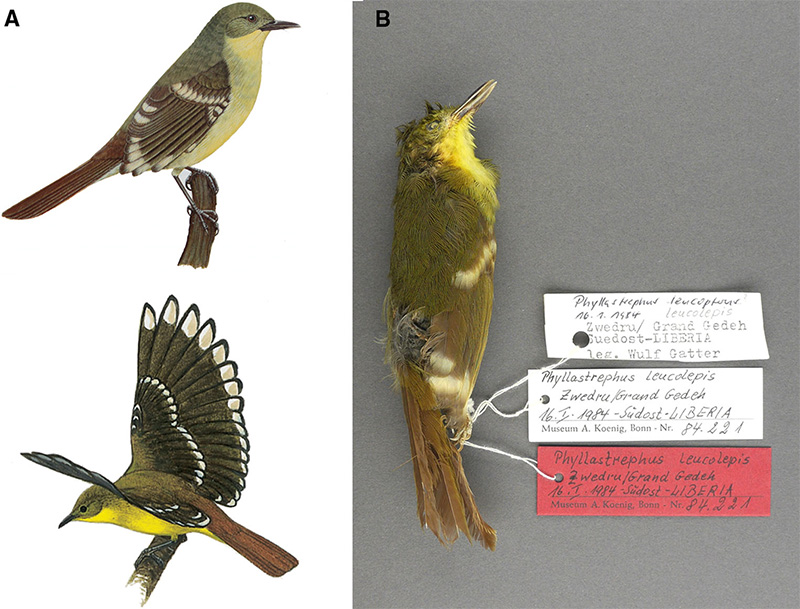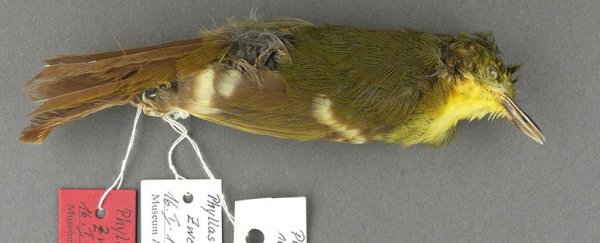In a truly fascinating case, scientists have discovered that what was once thought to be an extremely rare, elusive songbird in Africa, may have never existed after all.
For more than 30 years, experts tried to catch a glimpse of a bird so evasive it was deemed almost mythical. And last year, DNA analysis pointed to an explanation for these frustrating efforts – and it's bad news for the bird's entire species.
This weird story starts with a family of brightly-coloured, medium-sized songbirds that tweet all across Africa and Asia. Collectively known as bulbuls and greenbuls, they comprise approximately 130 species.
One of those species is a yellowish-green bird called the icterine greenbul (Phyllastrephus icterinus), a cute forest-dweller common across the entire western and central Africa.
In the early 1980s, German ornithologist Wulf Gatter came across a similar-looking species in the Cavalla Forest in eastern Liberia. It had unique colouring for any other greenbul - the tail was paler, the wings darker, and there were broad white spots at the tips of all the wing feathers.
 (Collinson et al., J Ornithol 2017)
(Collinson et al., J Ornithol 2017)
Gatter saw the bird demonstrating its wing spots in a way that appeared different from the similar icterine greenbuls hanging out nearby.
After glimpsing these birds across nine occasions, he finally collected one specimen in 1984 and described it as new to science, naming the bird the Liberian greenbul (Phyllastrephus leucolepis).
Then, nobody saw it again for decades.
Partly, this was because of the civil wars ravaging the country in the 90s and early 2000s, which prevented new ornithology expeditions doing additional sightings to learn more about the species.
And partly, it was probably because there was nothing to be found.
After two targeted search missions in 2010 and 2013 that yielded no additional specimens, an international ornithologist team changed their tactic and turned to DNA analysis.
In 2017, these researchers from the UK and Germany - including Gatter himself – published their results. According to the data, the most likely explanation for a lack of new Liberian greenbuls is the fact that they don't actually exist.
Two independent teams ran analysis on DNA samples from the sole Liberian greenbul specimen and two other greenbul species - the icterine and the white-throated greenbul.
In the end, the Liberian and icterine greenbuls turned out to share an astonishing amount of genetic similarities, much more than any other two species of greenbul.
"The genetic work was performed independently by scientists here in Aberdeen and in Dresden to make sure there could be no error - we both came to the same conclusion," says geneticist Martin Collinson from the University of Aberdeen.
"We can't say definitively that the Liberian greenbul is the same bird as the icterine greenbul, but we have presented enough evidence that makes any other explanation seem highly unlikely."
And it's not like the purported new species was even a hybrid - analysis also excluded that probability, leaving the researchers to hypothesise that the 'Liberian' greenbul was just an icterine greenbul with a juvenile nutritional deficiency that caused changes to its plumage.
Bummer.
But despite the thorough genetic analysis and unlikely alternative explanations, we can't yet say that the elusive birds absolutely, definitely don't exist - it looks like once something becomes a species, unspecying it is a tougher ask.
"Formal resolution of the status of the Liberian greenbul will not be possible until either a population of [them] is rediscovered or alternatively shown not to exist," the team writes in the study.
The spotted birds certainly don't live in their original location any more, but it's possible they have migrated to another area due to deforestation.
Or… you know, they really don't exist.
The research was published in the Journal of Ornithology.
A version of this article was first published in October 2017.
